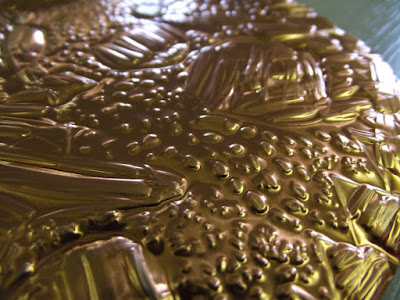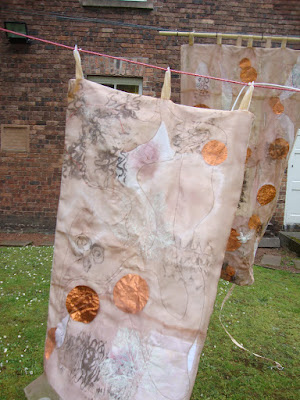 |
| Skyground: Installation in Tullie House garden |
 |
| Interpretation panel |
This week another of the big projects I've been working on has reached completion. I wrote a little bit about the project a while back and thought now would be a good time to share the completed work. The project was run by Prism Arts and commissioned by Tullie House as part of their Anselm Kiefer Artists Rooms exhibition. Myself and sound and digital artist Mark Newport worked with students from James Rennie School and Beaumont College in Carlisle to create an audio visual installation in the grounds of Tullie House inspired by Kiefer's work. The work consist of three fabric banners, two of which contain LEDs and one which when triggered creates a soundscape.
 |
| Tea bag tie dye |
 |
| Tea bag tie dye |
 |
| Tea bag tie dye |
Having started out with paper collage, frottage and pattern making on paper we moved onto working with fabrics. Just as we had prepared our papers before collaging them we also prepared our fabrics, this meant having a go at tie dye using tea bags! I'd never done this before but as one of the activities the students had really engaged with had been using tea bags to prepare paper I thought it would be an interesting experiment. One of the themes we'd been looking at was landscape and environment so it was important to use natural materials like cotton and silk.
 |
| Tea bag tie dye |
I prepared the fabrics by mordanting them with salt and vinegar to help the colours from the tea bags 'stick' to the fibres. I did this at home as there was a lot of fabric to prepare and it's quite a boring process, I wanted the students to get stuck into the interesting bits. To make the tie dye patterns we tied different types of tea bags (fruit and 'normal' tea) into the fabric. We then put them in buckets of hot water and allowed them to soak for most of the day. This meant that I went home with lots of tea sodden fabric but it did smell delicious!
 |
| Tea bag tie dye |
 |
| Tea bag tie dye |
 |
| Tea bag tie dye |
This process worked really well, although the students all thought I was a bit crazy. The tie dye created beautiful, subtle patterns and it was really interesting seeing how the two different fibres (cotton and silk) reacted differently to the dye.
 |
| Printing with our string print blocks |
 |
| Printing with our string print blocks |
 |
| Printing with our string print blocks |
To embellish the fabrics we'd prepared we used the string print blocks we'd made, leaves and stitch to make patterns based on the work we'd done on paper. The patterns we made were inspired by the different wave shapes different sounds make, as demonstrated by Mark, and by patterns on Roman coins and artefacts which again tied the piece back to the landscape and the site of the installation.
 |
| Leaf print |
 |
| Printing with white |
 |
| Leaf prints |
As well as the fabric pieces we also worked on circles of embossing foil to create the sensors to trigger the sounds and create the soundscape in the finished piece. We used knitting needles to transfer the designs we'd developed on paper onto the foil. Some of the circles the students created are beautiful objects in their own right.
 |
| Embossed foil sensor |
 |
| Embossed foil sensor: Detail |
Once the students had made their sensors and prints and embellished them with stitch we had a collection of small pieces ready to be made into complete hangings. Similarly, Mark had a collection of sounds made by the students ready to be collated into a soundscape.
 |
| Embellishing with stitch |
 |
| Embellishing with stitch |
 |
| Embellishing with stitch |
Because no one has really done a project like this before we encountered quite a lot of technical issues along the way, not least because the work has to hang outside so needs to be Cumbrian weather proof. It took Mark and I a lot of time to put the work together and get everything working, problem solving as we went along. We have used a lot of insulating tape!
 |
| We housed the electric in Tupperware! |
 |
| Connecting everything up |
 |
| LEDs sewn in |
The installation consists of three fabric banners, composed of the prints and fabrics the students made and the embossed foil sensors. There are two smaller banners which hang in front of the larger banner. The sensors in the smaller banners activate a series of LED lights when triggered and the sensors in the big piece activate different sounds, creating a soundscape. Sometimes the sensors are triggered by the wind or the fabric folding in on itself which adds another element to the work. The sensors are connected to the electronics using conductive thread, I really enjoyed working with this as it is a lovely material to work with and I like the challenge of making sure the circuits work but also look good and fit with the aesthetics of the piece. I used the drawings of the students to create the patterns for the circuits.
 |
| Installation view |
 |
| Small banner |
 |
| Small banner: Detail |
Despite our best efforts we were delayed installing the piece because of the weather. We had hoped that at the end of May,beginning of June the worst we'd have to deal with was a bit of drizzle but instead we got torrential downpours and strong, gusty winds. Luckily, on the day of the launch, despite it being very cold, the rain did hold off until after the event. We're hoping to have the work up until September but given what the weather has thrown at us so far that may not happen!
 |
| Small banner: Detail |
 |
| Large banner: Detail |
 |
| Triggering the soundscape |
The launch was a really good event, the students came down from James Rennie and there were people from Tullie House, Prism Arts and The Heathlands Project there, probably about 40 people all together. The response to the work was very positive and even better was the response of the students who had been involved, they were really proud of their work and wanted to shoe it off and tell people about it.
 |
| Small banner LEDs: Detail |
 |
| Small banner: Detail |
This was a really interesting project to work on and demonstrated the importance of having time to develop relationships with the people you're working with. The first few weeks were quite difficult, we were dealing with a difficult subject matter (Kiefer's work is not the most easily accessible) and the students struggled to engage with some of the concepts. After about three weeks (so three sessions) the students really started to open up, they were much more responsive to what we were doing and more willing to contribute their thoughts and opinions.
 |
| Sensor: Detail |
 |
| Sensor: Detail |
I believe this was partly because they'd had time to get used to the subject and partly because they'd had time to get used to and trust Mark and I. I also think that the practical work we did with them from the start really helped because whenever we were doing something the students seemed to find it easier to communicate their thoughts and ideas. I'm a big believer in thinking through making and I think our experiences with this group support this idea.
I've learnt a lot from this project and am looking forward to doing more work combining fabric and sound, I think the two work together well and can be used to create meaningful and personal site specific installations.
No comments:
Post a Comment